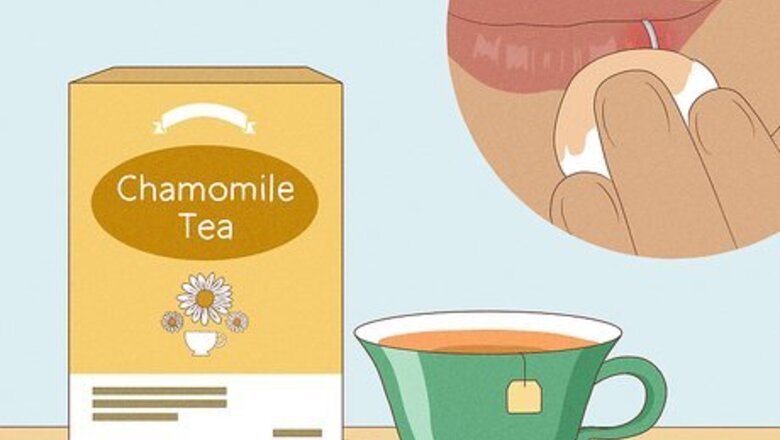
views
- Use a cool chamomile tea compress and NSAIDs or acetaminophen to treat pain after your appointment. Consume cold foods and drinks to soothe oral piercings.
- Keep your piercing clean with saltwater or saline and avoid touching or removing it as much as possible while it heals to promote healing and prevent infection.
- Wash the piercing 3 times a day and apply antibacterial ointment after each cleaning if it’s infected. Mild infections usually last 1-2 weeks.
- Reduce needle pain with numbing creams, acetaminophen, or meditation and deep breathing. Visit a professional piercer for the least painful experience.
Pain Relief

Apply a chamomile tea compress to the piercing site. Steep a bag of chamomile tea in boiled water for 10 minutes, then dab a clean cotton pad or piece of gauze in the water once it’s cooled. Squeeze out the excess liquid and hold it to your piercing for a few minutes. Use the tea compress up to 3 times per day. If you run out of cotton pads or gauze, try squeezing the water out of the tea bag itself and holding it to your piercing. Chamomile penetrates deeper layers of skin to fight inflammation, kills germs because it’s antimicrobial, and feels soothing on skin.
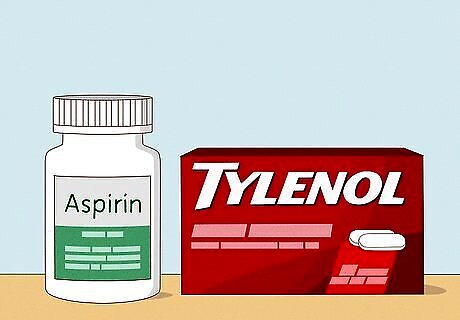
Take over-the-counter anti-inflammatory pain medicine. Use an NSAID (non-steroidal anti-inflammatory drug) like ibuprofen (Advil, Motrin), naproxen (Aleve), or aspirin to treat both pain and inflammation. If the site is just painful and isn’t swollen, try acetaminophen (Tylenol). Read the instructions of the medication to make sure you’re taking the correct dosage. Make sure you aren't allergic to any ingredients and check with your doctor to see if any painkillers will interact poorly with your existing prescriptions.

Consume cold foods and liquids to soothe oral piercings. Try sucking on ice cubes or popsicles, especially within the first 24-48 hours after a lip, tongue, or cheek piercing. Drink lots of ice water and other cold beverages and eat cold foods like ice cream, frozen yogurt, or pieces of frozen fruit. Avoid warm beverages, hot or spicy foods, tobacco, alcohol, or anything that irritates your mouth. Non-oral piercings shouldn’t swell much, so skip icing them for pain relief. The extra pressure from an ice pack could actually make the piercing swell or hurt more.
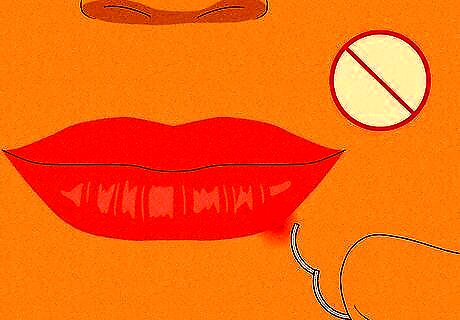
Keep your piercing in until it’s healed, even if it’s painful. Double check how long your piercer recommends leaving your jewelry in before removing or swapping it out. Leave the piercing in until you heal it fully—removing the piercing can delay the healing process, and putting it back into an unhealed hole can be painful. Most piercings take 6-8 weeks to heal, but it depends on the exact location and is different for every individual. Some piercings, like belly button or nipple piercings, can take up to 12 months or more to fully heal.
Aftercare

Follow your piercer’s aftercare instructions to a T. Make sure to chat with your piercer about keeping the piercing clean and healthy, and ask for a pamphlet or printout so you can remember the details (reputable piercers should give one to you automatically). If you don’t have specific instructions, clean the piercing twice a day with sterile saline or a piercing aftercare solution. Don’t use a cotton swab to wipe the piercing, since this could irritate the area and ultimately slow down healing or even lead to scarring.
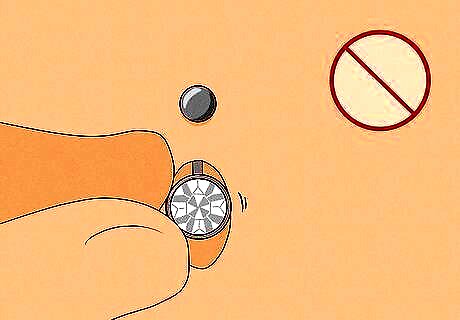
Resist the urge to play with your piercing. Only touch your piercing as necessary to clean it while it heals. Twisting or tugging on your piercing will cause more pain and irritate the piercing site. Germs from dirty hands are also the main cause of infections, so follow the old rule of “look, don’t touch!” The less you mess with your fresh piercing, the faster it will heal up.
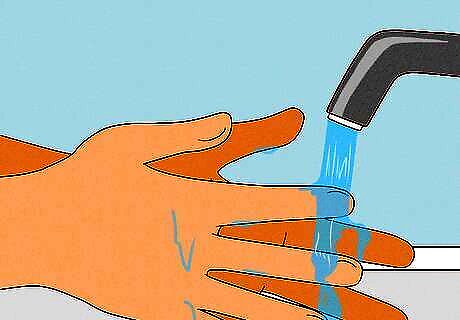
Wash your hands before every time you handle or clean the piercing. Scrub your hands with clean, hot water and antibacterial soap for at least 20 seconds. Get all areas of your hands, especially your fingertips and underneath your nails. Touching the piercing with dirty hands is the most common cause of infection.
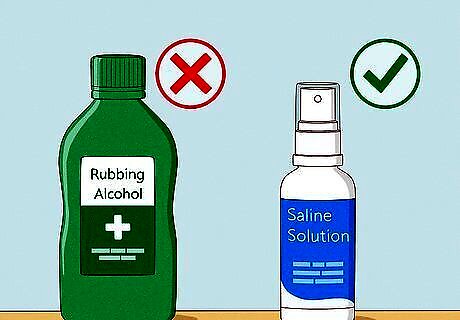
Clean the piercing with saline, saltwater, or piercing solution twice a day. These mixtures keep the area clean without irritation or killing new cells. Avoid chemicals like hydrogen peroxide, iodine, or rubbing alcohol during healing. They’re harsh and will irritate the site, plus they’ll kill any new, healthy cells and delay healing. Unless there’s an infection, avoid using any ointments. They attempt to heal the skin and might block oxygen from reaching deeper tissue. To do a saltwater soak, submerge the piercing in a small bowl full of saltwater spray or sterile saline solution or hold a dampened cloth to it for 5-6 minutes. Make saline with ¼ tsp (1.5 g) of sea salt dissolved in 8 fl oz (240 mL) of boiled water. If the solution is too salty, it will irritate your skin.
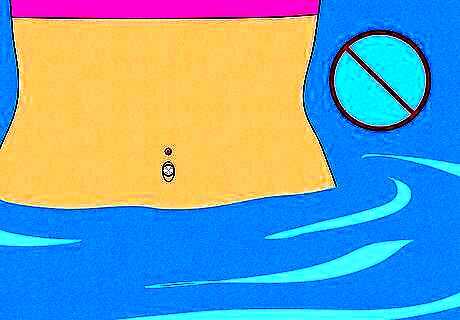
Keep the piercing as dry as possible. Outside of cleaning the site and showering, do your best to avoid soaking your piercing in any kind of water while it heals (6-8 weeks for most piercings). Avoid swimming in pools, rivers, lakes, or oceans, as well as soaks in a hot tub or a bath. Chlorine in pools or contaminants in open water can irritate or infect a fresh piercing. The older the piercing, the better it will hold up in water.
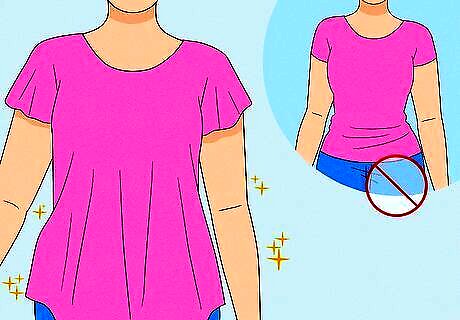
Clean any clothing or bedding that might touch the piercing. If possible, try to keep anything from touching the piercing while it heals, including clothes, hair, your hands, or bedding. This isn’t always practical, so make sure to wear clean clothes, wash your bedding, and try not to sleep on your pierced side since germs from sheets or pillow cases can cause infection. If you have long hair, pull it back to keep it out of ear, eyebrow, or lip piercings. Talk to your piercer about protecting piercings in places like your navel or nipple. You may have to wear gauze or loose-fitting clothing for several weeks.

Stay hydrated, eat a nutritious diet, and get plenty of sleep. A healthy body and immune system heal piercings faster and reduce pain, so make sure to drink plenty of water (and limit your alcohol intake), eat lots of fruits and veggies, and try to get a good night’s sleep every night while your piercing heals. Try taking a multivitamin or adding more vitamin C to your diet, too. Diet and sleep don’t reduce pain right away like NSAIDs or a chamomile tea compress, but they limit pain in the long run during healing.
Treating an Infection
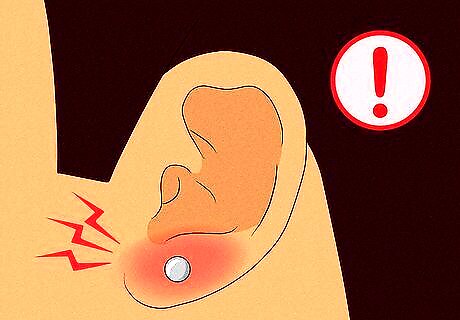
Look for signs of infection like redness, swelling, or pain. Ignore mild redness or tenderness during the first few days after getting a new piercing since this is a normal part of healing. Notice if your piercing isn’t improving day-to-day or if it seems fine for a week or two and then suddenly becomes red, swollen, or crusty. Look for common infection symptoms like: Swelling or inflammation Redness Pain or tenderness around the piercing site Discharge that may form crust around the piercing
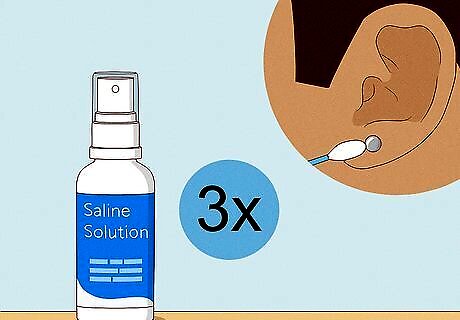
Keep the piercing in and clean it 3 times a day. Wash your hands before touching the piercing and then dip a cotton swab in sterile saline or piercing care solution. Gently rub any part of the jewelry that’s exposed, plus the skin surrounding it. If you can, rotate or turn the piercing 3 times to keep skin from sticking to the post. Gently pat the site dry with a clean paper towel or let it air dry. Do not use a cloth or towel since these are more likely to spread germs. If the piercing is old and fully healed, use rubbing alcohol in place of saline or piercing solution.
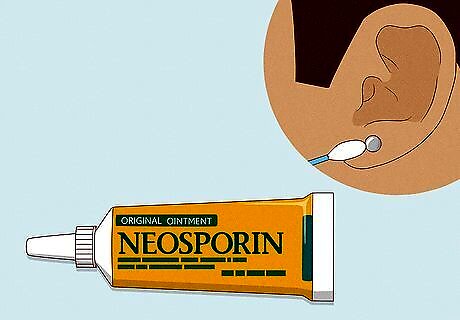
Apply over-the-counter antibacterial ointment after each cleaning. Rub a small amount of ointment onto the skin around the piercing to kill germs and prevent the infection from worsening or spreading. Use any ointment you might have on hand in a first aid kit like Neosporin or Polysporin. Wait until the piercing is dry after cleaning it to apply any ointments.

Stop treating the infection once symptoms disappear for 2 days straight. With proper care, most piercing infections will clear up in 1 to 2 weeks. Once the infection is gone, keep cleaning your piercing daily until it’s fully healed to prevent the infection from coming back.

Call a doctor if your symptoms get worse or don’t improve after a week. Look at your piercing daily and check the infection’s redness, swelling, discharge, and pain. If symptoms haven’t improved after a few days of treatment, visit your healthcare provider for an antibiotic or other treatment. Signs of a severe infection include: Losing feeling or getting a tingly sensation in the piercing area The skin near the piercing turns pale or cool The piercing starts to bleed enough to soak through a bandage (a small amount of blood oozing from a new piercing is normal)
Minimizing Needle Pain

Make sure you see a licensed, professional piercer. Research the piercing studio’s website and their piercers’ biographies or social media to get a sense of how legitimate they are. Read reviews to see if the studio and equipment are clean, and make sure the piercer is transparent with you when you ask questions or voice concerns. Visiting an experienced piercer who works in a clean environment limits the chance of a super painful or rough piercing and infection. Professionals know exactly where to insert new piercings and can give you detailed instructions on aftercare to prevent pain and infection.
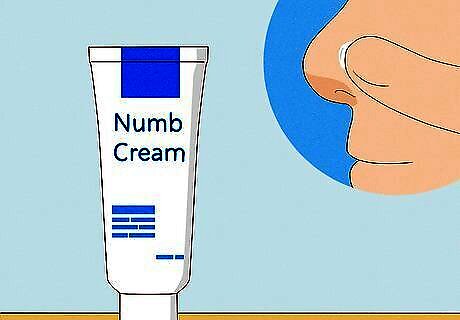
Apply a numbing cream or spray to the site 30 minutes beforehand. Try an over-the-counter numbing agent with ingredients like lidocaine or prilocaine and spray or rub it into the skin you want pierced before your appointment. Read the ingredients to make sure you’re not allergic to anything in it, since this can make the piercing more painful. The numbing effect will probably last for about 30-60 minutes. Numbing creams and sprays only affect the top layers of skin. You’ll still feel the needle, but it will hurt less than without the cream.

Take extra-strength acetaminophen about an hour before your piercing. Read the instructions on the packaging of pain relief pills containing acetaminophen, like Tylenol or Excedrin, and take only the recommended dose. Avoid aspirin or ibuprofen, as these can thin your blood slightly and increase your chance of bleeding.

Try breathing exercises or meditation to get in a calm state of mind. Try some deep breathing exercises to slow your heart rate, relax your body, and mentally prepare yourself for brief pain. Alternatively, try meditating before your appointment while focusing on how excited you are to have a new piercing and how great it will look! Try out this simple breathing exercise: plant both feet on the ground and slowly inhale for 5 counts through your nose, then exhale for 5 through your mouth.




















Comments
0 comment